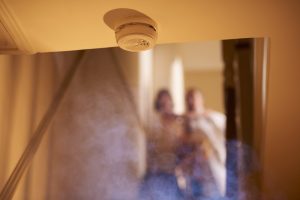The prospect of a profitable sale can push REALTORS® and individual homeowners alike to list a home before it’s truly ready to hit the market. However, due to the Breach of Duty regulations, a real estate agent can be at risk of a lawsuit if a homebuyer finds problems with the house that were not disclosed during negotiations. That’s why it’s so important to perform a thorough safety check before listing a home for sale. Home safety includes all of the grounds, so this guide will cover everything from in-home to out-of-home safety. Much of this information comes from the Home Safety Guide published by ConsumerSafety.org.
Lawn, Landscape and Pool Safety
Pools are far and away the most dangerous part of a residential home, with one child under 14 a day drowning on average. There are several steps a homeowner should take before listing a home with a pool for sale:
- Install VGB-compliant drain covers
- Properly store hazardous pool chemicals away from the pool site
- Ensure the pool is covered with an adequate safety cover
Nearly every American suburban home has a lawn, but most people aren’t aware of the potential safety hazards. Here are some actionable steps to take before listing:
- Remove pet feces and sharp items like rocks or glass from the yard
- Check for poisonous/harmful plants like poison ivy and remove if present
- Properly store weed killers with hazardous chemicals away from the lawn
Fire Safety
The average monetary value of property damage from a fire was $16,610 in 2016, according to data collected by the National Fire Protection Association (NFPA). If the homeowner is accused of negligence, they will have to pay for all damages. This is why properly removing fire hazards in the home is essential.
Before listing the home for sale, check for damaged plugs and appliances, overloaded outlets and multiple extension cords. All three of these are risk factors for a home fire. Additionally, you’ll want to ensure that outdoor cooking appliances like grills are at a safe distance from the home.
Kitchen Safety
It shouldn’t be a surprise that the kitchen is one of the most hazardous areas of the home, since it has the most electrical and gas appliances. One crucial but often overlooked safety feature of a kitchen is a working fire extinguisher. By purchasing one and leaving it in the kitchen, you will be preventing any negligence lawsuits pertaining to grease or electrical fires.
This is less of an issue for REALTORS®, but if you’re a homeowner looking to rent all or part of your home, you’ll want to make sure that the kitchen is childproofed if the incoming owners have small children. Since many sharp utensils can be found in the kitchen, either keep them out of reach of children (in a high cabinet) or, even better, ensure they’re secured with a childproof lock.
Hopefully these guidelines can help you as a REALTOR®, real estate agent or individual homeowner minimize the risk of lawsuits. By taking the actionable steps from this Home Safety Checklist and applying them to the relevant instances in your home, you will be much less likely to become a victim of a negligence lawsuit. And you will also keep the future owners safe, which is as important as anything.
Cal Cook is Consumer Finance Investigator at ConsumerSafety.org.








